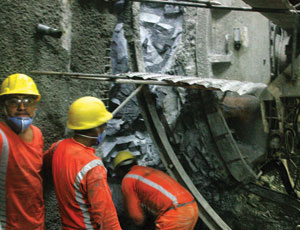An ambitious project to bore a tunnel through the Continental Divide in the Andes of northern Peru has stalled after a powerful rock-burst severely damaged the tunnel-boring machine drilling the underground passage.

On April 29, a large rock-burst struck the $14-million, 5-meter-dia, unshielded Robbins gripper TBM, damaging a cylinder connecting one of the grippers to the machine. Two workers suffered minor injuries when the operating cabin was partially crushed around them.
Officials with Odebrecht Perú Ingeniería y Construcción S.A.C., the local operating arm of the project’s Brazilian general contractor, say they do not know how long the stoppage may last. Currently, Robbins is searching worldwide for a replacement cylinder; if one cannot be found, it could take as long as six months to make a new one.
Peru’s department of Lambayeque awarded Odebrecht the $247-million concession in July 2004. Odebrecht says its engineer-procure-construction portion is worth $185 million, with $90 million allotted for tunnel work. The original contract called for the project to be operational by this month. The contractor and the government are in discussions over a contract extension.
“We will need an additional 400 days to have all the work done completely,” says Mauricio Cruz, project director.
If the TBM can be restarted in the next few weeks and there are no further rock-burst incidents, the earliest completion date would be July 2011, he says. There has been no cost put on the how much the delays will add to the job; the original contract budgeted tunneling at $30 million per year for three years.
The Los Olmos project is an effort to divert the waters of the Huancabamba River on the eastern slopes of the Andes to the dry Olmos River in order to irrigate farmland on the Pacific side. The effort requires a 20.1-kilometer-long tunnel, 14 km of which would be drilled by TBM.
The 2.1-km overburden makes the tunnel the second deepest under construction in the world (the Gotthard Base tunnel in Switzerland exceeds it by 113 m). The TBM has excavated more than 70% of the spoil to date; 3.7 km remain.
Rock-bursts caused by stress fractures occured sporadically from the start of the effort in 2007 but became a serious problem February 2009, when work ceased for 45 days. Since then, the frequency of the bursts has increased dramatically: More than 11,000 have been recorded, 110 of which had sufficient intensity to require at least a day’s shutdown of the TBM.
While Odebrecht engineers say they do not expect a tunnel collapse, there has has been a sharp slowdown. The average rate of progress for the first two years was 308 m per month. Since February 2009, the TBM has averaged only 110 m per month.
So far, the drilling machine has encountered volcanic rock types—quartz porphyry, andesite and tuff, which were predicted in prior geotechnical surveys—but they have exhibited an unexpected degree of fracturing, says Paulo Affonso, head of engineering and production.
“The type of rock we are encountering is actually very good,” he says. “The problem has been the extreme pressures it has released as we encounter it.”

Post a comment to this article
Report Abusive Comment